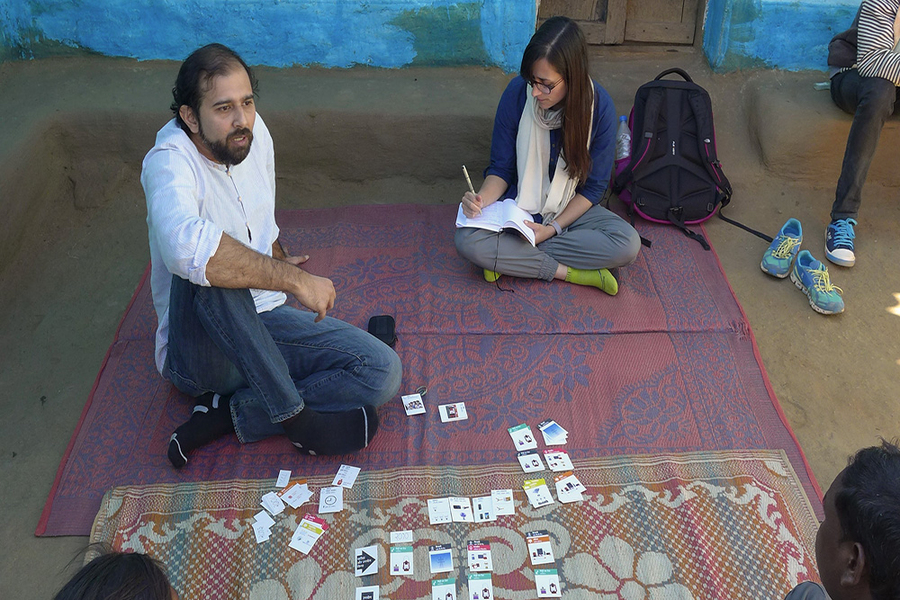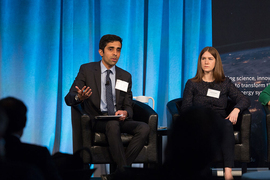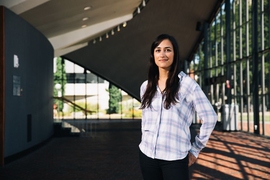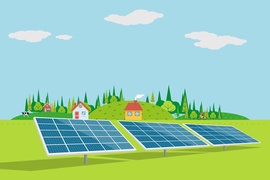More than 73 million households in remote areas of the world get electricity not from a conventional power grid but rather from sources such as solar lanterns, solar home systems (SHSs) that can power several devices, and local solar-based microgrids. Such off-grid devices and systems provide life-changing services to people who are off centralized electricity grids, and they help spread the use of renewable energy. As a result, international aid organizations and nongovernmental organizations (NGOs) are working hard to encourage their adoption.
To expedite the spread of solar technologies, such organizations need to understand the barriers and incentives for households to adopt them. Scholars have assumed that as household income increases, people will adopt newer, “higher-order” technologies and abandon older, “lower-order ones,” such as those that burn fossil fuels. But there’s clear evidence that in remote places people don’t easily abandon the energy sources they have — including their kerosene lanterns.
What motivates people in remote communities to decide to buy and use a particular energy source? What encourages them to choose a certain solar lantern? And why do they then hang onto some of their older devices after acquiring new sources such as a microgrid or even access to the state-run electric grid?
Three years ago, David Hsu, an associate professor of urban and environmental planning, and then-graduate student Elise Harrington PhD ’20, both of the Department of Urban Studies and Planning, decided to investigate those questions in remote villages in India. From preliminary work in the region, they knew that many households use a range of energy sources. If they were to figure out what had prompted a household to adopt and use particular technologies, they’d need to interview the whole decision-making group — a prospect they knew would be difficult. In the past, when Hsu and his colleagues knocked on doors to ask about interest in microgrid power, a crowd of villagers would quickly gather, the person with the highest status would respond, and everybody else would nod. For this study, he and Harrington needed to go into the home, determine what energy systems and appliances were present, and then get the family members to remember — together — how they had decided to purchase them and perhaps abandon previous systems.
The first challenge would be to get in the door. “There are many different social norms that govern access to private spaces,” says Harrington. “But as a woman, I was allowed into interior living spaces. So I got to see firsthand the appliances and lights and so on that were installed or in use.” In addition, she had learned to speak some basic Hindi so she could introduce herself, refer to appliances, and ask basic questions.
The second challenge was to get the group to remember decisions made in the past and what had motivated them — a process that could be both tedious and confusing. For help, the researchers engaged Ameya Athavankar of twobythree, a company based in Mumbai, India, that specializes in creating techniques using elements of game-playing for applications ranging from building and product design to marketing research. Athavankar quickly became an integral member of the research team, working to explore and test possible game formats and field protocols, helping to communicate in both Hindi and the local dialect, and leading the interviews.
Game-playing reveals choices
The United Nations recognizes six steps, or “tiers,” in the transition from having no electricity to being able to run high-power appliances. In their work, Hsu and Harrington decided to focus on the transition from no access to focused task lighting plus phone charging (tier 1), and then the move to general lighting, phone charging, and appliance use (tier 2). “Going from just kerosene to having electricity that provides you with basic lighting and charging can be a really transformative step for households,” says Harrington.
In consultation with a local microgrid company and an NGO with a local office, the researchers selected three villages in the Gumla District of Jharkhand, India, for their study. Two of the villages — Bartoli and Neech Kobja — had access to the state-run electricity grid. The third village — Ramda Bhinjpur — had access to a private microgrid but not to the state grid. Within those three villages, the team selected a total of 22 households that represented a range of experience with solar technologies and fuels used for basic household lighting and charging.
The photo below shows the result of using the researchers’ game-based protocol in one interview. In the game, colored playing cards represent five energy sources for lighting: a kerosene lantern, a solar lantern, an SHS, a microgrid, and the state grid. The layout of cards here shows the respondents’ choices at a series of decision points, moving in time from left to right. Each column shows the result of one decision, with cards in the top row representing “primary sources,” cards in the second row “backup sources,” and cards in the third row sources that have been eliminated for lighting use.

In this interview, respondents started with a kerosene lantern (green card) — the initial lighting source in most households. Next they added a black card representing the state-run grid in the top position and moved the kerosene lantern down a row, indicating that they retained it in their household “stack” of energy sources but used it less. They then added a solar lantern (red), using it in tandem with the state grid such that both were primary sources. The solar lantern then broke — as indicated by the red card with the crossed-out image. Finally, they added a solar home system (orange) that they used along with the state grid, while retaining their kerosene lantern.
Purchase and use patterns
Following the same protocol, the researchers performed interviews at 22 households across the three villages. They then added up the sources cited as primary and as backup at each decision point across two groups: at microgrid households and at households connected to the state grid.
The two groups show some marked differences in behavior, beginning with their move away from their kerosene lanterns. The microgrid households moved kerosene lanterns to backup as soon as they had other options available, whereas the state grid group continued to use their kerosene lanterns, only gradually shifting them to a backup position.
Households in both groups adopted solar lanterns, and many continued to use them as a primary source even after being hooked up to a microgrid or the state grid. One reason cited was that solar lanterns can provide lighting for outdoor activities after dark. Perhaps more important, a government program was providing discounted solar lanterns through schools in all three villages.
SHSs were also adopted by both groups. Indeed, many in the microgrid group went directly to an SHS, essentially leapfrogging over the solar lantern option. Once the two groups got grid access, their treatment of their SHSs differed: The microgrid households soon moved much of their SHS use into a backup position, while the state grid households continued to use their SHS as a primary source.
The researchers stress that these interviews offer insight into household use patterns for solar power: Although the sample may be small, it provides rich qualitative data for understanding household decisions. And they did observe some interesting trends. For example, when households connected to a microgrid, they often shifted their existing sources to a backup position, using them on occasion to help defray the cost of the microgrid.
In contrast, households that got access to the state-run grid frequently added both a solar lantern and an SHS, and continued to use them — even increasing their use over time. Moreover, they kept using their kerosene lanterns, only gradually moving them into a backup position. The state grid is notoriously unreliable, so people need to maintain good alternatives for use during blackouts.
Explaining the choices
To delve deeper into what influences technology choice, the researchers asked at each decision point why changes had been made. Using a second set of cards, they asked respondents about the possible importance of five factors: awareness, availability and access, capacity, unit pricing, and quality.
The adoption of every energy technology — but especially the SHS and microgrid — was intended to increase system capacity to meet more end uses, including additional appliances. People cited pricing and payment options as influencing their decisions to acquire solar lanterns and SHSs. Decisions to connect to the state grid were totally dependent on access, whereas decisions to connect to a solar microgrid were more heavily influenced by awareness of the technology.
Notably, failures in the quality of higher-order sources often influenced the retention of lower-order sources. Fully 90 percent of respondents mentioned capacity as influencing their decision to retain their SHS, citing its ability to provide brighter light and greater coverage than other sources. Solar lanterns were retained for their portability and ability to provide better-quality light for studying and other indoor activities. Most households retained kerosene and solar lanterns as well as SHSs to provide coverage during state grid or microgrid outages.
The researchers cite several responses as unexpected. For example, when purchasing an SHS, respondents were initially interested in financing — until they learned about the interest rate and the monthly payments. In general, respondents said that they preferred to make cash payments all at once because their household income varies with the season. Interestingly, other areas of the world with growing off-grid solar markets often have strong programs of pay-as-you-go financing for solar products.
Even more surprising to Harrington was finding that the people interviewed typically paid little attention to warranties or quality labels when making purchases. “There are important efforts in India, and internationally, that focus on setting technical quality standards and providing labeling and certification to communicate those quality standards to consumers,” she says. “But we found that what matters to people is their personal relationship with a shop owner or with the person or organization that introduces them to a solar product.”
Powering appliances
Finally, the researchers looked at what appliances and activities people supported with an SHS, microgrid, and grid. They grouped households into three categories by income and compared end uses across those three electricity sources.
For the high- and middle-income groups, an SHS permitted the use of high-watt devices such as fans, televisions, and laptop computers along with mobile phones and lights. Connection to either the state grid or a microgrid enabled those income groups to undertake income-generating enterprises such as operating a convenience store or running an electronics repair shop. That finding is notable because many aid organizations and microgrid operators emphasize the importance of enabling productive activities when providing electricity to underserved populations.
For the lowest income group, an SHS made possible the first move in electricity access — getting mobile phones and lights. But once on the state-run grid, even some of the most financially constrained households could run televisions and fans as well. “For all the discussion about the challenges with grid reliability and quality, you also see this amazing opportunity that the grid provides to those in our study with the lowest income,” says Harrington.
Policy implications and plans
The researchers’ findings demonstrate the value of introducing SHSs and solar lanterns to provide basic lighting and charging capability before the grid is available. In some cases, supporting adoption of those technologies is the most cost-effective approach to spreading electrification, at least in the short term.
The study also shows that people tend to buy solar devices and services in response to interactions with those whom they trust. In one case, a village decided to participate in a microgrid after an NGO well-known to the community organized a trip to see a microgrid in another village. More such efforts at consumer education and engagement may be needed to support off-grid solar.
Finally, the research confirms the value of the card-based interview technique for data collection and subsequent analysis. Taking a photograph of the laid-out cards at the end of each interview proved important to remembering and then analyzing the timeline and key factors influencing the decisions made at each step. “If we had just done interviews and transcriptions, I don’t think we ever would have made sense of what people’s decision process was,” says Hsu. “People don’t always remember the sequence or rationale for their energy adoption choices until you give them a way to record their experience.”
The researchers also see another potential application of the technique. Setting up a microgrid to provide different levels of service to households in a village requires a high degree of collective decision-making. Perhaps a version of their card-playing interview technique could support that decision-making, ensuring that every household is heard and gets what it needs from the proposed microgrid.
This research was supported by MIT’s Tata Center for Technology and Design, which is part of the MIT Energy Initiative.
This article appears in the Autumn 2020 issue of Energy Futures, the magazine of the MIT Energy Initiative.










